The iconic Komodo dragon may be in danger. Here’s why

AN INTERNATIONAL team of scientists, including Australians, has called for the development of new reserves throughout Indonesian islands that are home to the world’s largest lizard, the Komodo dragon, which is being threatened by climate change.
This large monitor species, famous for its deadly saliva and impressive strength, prefers to live in coastal lowland forests, not too close to the coast and not too far inland.
“Because their habitats are quite restricted, there is a high risk from climate change, as they don’t have many options for moving if they lose habitat patches,” says researcher Alice Jones from the University of Adelaide’s School of Biological Sciences.
Climate change and Komodo dragons
In a paper published recently in the journal Ecology and Evolution, scientists collated information about the dragon’s biology, including lifespan and movement patterns, and combined this with climate and sea-level change projections to predict the dragon’s future range and abundance when faced with different climate change scenarios.
Under a business-as-usual approach to greenhouse gas emissions, the Komodo dragon may lose up to 87 per cent of its habitat. As a result it could experience a decline of up to 99 per cent in its population as the forest contracts, the drier savannah woodland expands and water inundates the species’ island homes.
In response to these devastating predictions, the scientists identified key areas for protection.
Across the Indonesian islands of Komodo, Flores, Rinca, Nusa Kode, and Gili Motang, scientists say Flores, which is currently not a part of the World Heritage-listed Komodo National Park and therefore mostly unprotected, could be transformed into a safe haven for the dragons.
These new safe havens on Flores, Alice says, must be in areas of good habitat that are predicted to be sustained into the future based on climate projections, ensuring the new protected areas are not negatively impacted by global warming or sea-level rise before the middle of the century.
The paper mostly stresses, however, the importance of ensuring habitat on the two largest protected islands, Komodo and Rinca, remain well-managed, because they will be key strongholds for the dragon as climate change continues to set in. On those islands, scientists are particularly concerned about the expansion of ecotourism exacerbating habitat loss.
According to Tim Jessop, another Australian scientist involved in the study and a scientific advisor to the Komodo Survival Program, climate change will also have a more direct impact on Komodo dragons.
“Being cold-blooded, these lizards use behavioural means to regulate their body temperature,” Tim says.
“If the environment gets hotter, it’s harder for these very large lizards to cool down, which they often do by spending more time in the shade. If they spend more time in the shade, then there is less time for other activities such as feeding that can have negative impacts on individuals.”
Australia, one of the highest emitters of greenhouse gases
Alice says a drastic reduction in global greenhouse gas emissions will be key to avoiding the Komodo dragon’s demise.
“Globally, we are doing a dismal job of emissions reductions and Australia is one of the highest emitters of greenhouse gases per capita in the world,” she says. “
“We urgently need to take action to decarbonise the economy in Australia and elsewhere.
“Climate change is a global issue and the changes that we make in Australia can make a difference to the survival of species in other parts of the world, like the Komodo dragon, as well as to many species here in Australia that are threatened by the impacts of climate change.”
People are concerned about these findings, Alice says. However, she adds that while this new paper specifically highlights the impacts of climate change on Komodo dragons, the entire ecosystem they are part of will be impacted.
“We hope that we can use the iconic dragons as an ‘umbrella’ species – that our work will get attention, due to their iconic status, but that any actions taken may also help a broader range of species that inhabit the same environments.”
The study is currently being translated into Bahasa Indonesian so that it can be communicated to local and national conservation management authorities who can help improve local understanding of the potential consequences of climate change on the Komodo dragon.
Read the new paper here.

